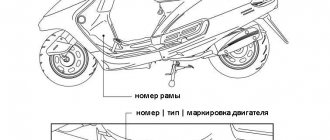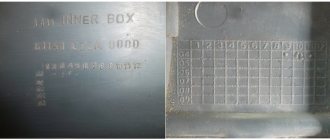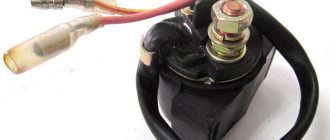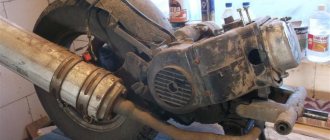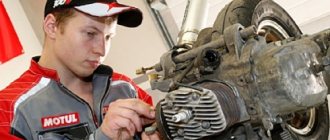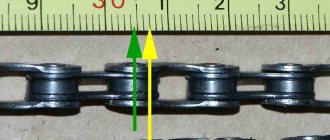Running in the engine
Incorrectly carried out running-in of the 139QMB engine in most cases leads to failure of the piston system.
Friction occurs between the parts of the new CPG, which leads to an increase in engine temperature. Running in the scooter motor is carried out as follows:
- The scooter is placed on the center stand.
- Within 5 minutes the engine starts at idle speed, the field of which cools down during the same time.
- Over the next 10 minutes, the engine also runs, after which it cools down for 15 minutes.
- The engine is restarted for 15 minutes, then turned off and left to cool for 15 minutes.
- The scooter is started again for 30 minutes, after which it is turned off and left for 20 minutes.
After carrying out such manipulations, you can run in the scooter itself. In the first 100 kilometers of the journey, you should not turn the throttle handle more than 1/3 of its full stroke. The maximum speed should not exceed 30 km/h. The speed can be increased by 15–20 km/h for the next 300 kilometers - during this time the engine should more or less reveal its potential.
After this break-in process, the oil must be changed.
Engine valves are adjusted every 500 kilometers.
Piston installation
Insert a retaining ring into any boss of the piston pin. It is most convenient to insert the ring with small round nose pliers. After installation, check how well and tightly the retaining ring fits.
- If the retaining ring does not cover the entire surface, but only a small part of it, replace it with a new one.
- If the retaining ring does not lie tightly in the groove and dangles, straighten it a little
Lubricate the bearings of the lower and upper connecting rod heads and the piston pin bosses with clean engine oil. We put the piston on the connecting rod, orienting it with the “IN” mark to the inlet port; if there is an “arrow” on the piston instead of the “IN” mark, orient the arrow to the exhaust port. We insert the piston pin into the boss - orient the piston on the connecting rod so that the pin hits the connecting rod - install the pin all the way into the locking ring and secure it from falling out with the second locking ring.
We install the cylinder guide bushings on the studs and put on the gasket. It is advisable to place the gasket on the sealant, but without fanaticism.
Sizing engine pistons
- D out - outer diameter of the piston, mm
- Auto – engine brand/manufacturer
- Model - engine name, in some cases car model name
- Cylinders - number of internal combustion engine cylinders, number of pistons in a set
- K1 - thickness of the 1st compression ring, mm
- K2 - thickness of the 2nd compression ring, mm
- K3 - thickness of the 3rd compression ring, mm
- M1 - thickness of the 1st oil scraper ring, mm
- M2 - thickness of the 2nd oil scraper ring, mm
The Teikin catalog provides comprehensive information: characteristics of rings, pins, stoppers, surface shapes. To understand all the abbreviations. Read the transcript information below.
- Ø—piston diameter
- CD - distance from the pin axis to the upper plane, mm (piston compression distance in millimeters - verbatim from the catalogue) The plus value indicates the height of the crown lift. The minus value indicates the depth of the completed (cavitation) crown
- TL—total piston height, mm
- Surface Treatment - surface treatment method TIN COATED - tinning
- MOLY SKIRT – tin coating
- ANODIZED CROWN - anodizing
- MRC (MINIMUM RECOMMENDED CLEARANCE.) - minimum recommended clearance at the measurement point
- suffix “A” - piston with a reinforcing insert for the first compression ring
- suffix "FK" - full trapezoid of the ring
- Ø—nominal pin diameter, mm
- TL - sleeve length, mm
- Prefix “LKSX” means linerkit with semi-finished and no flange liners
- Prefix “LSX” means liners are semi-finished and no flange
Original description of parameters, see
Article source: https://size.name/catalog/porshnya
How to extend the life cycle of CPG
It is not recommended to drive the scooter at maximum speed for long periods of time (especially in hot weather). This can lead to thermal seizure, which leads to deformation of individual parts of the CPG. As a result, the highest speed of the vehicle will be unattainable due to the loss of pressure inside. When disassembling the structure, the sticking is easily determined by the presence of burnt parts in the form of tongues. Carburetor adjustments will be required to prevent deposits from forming in the muffler and combustion chamber and overall loss of power.
It is necessary to fill in high-quality motor oil that gives a positive effect:
- no noise from the engine;
- no overheating of the motor during prolonged operation;
- relatively clean exhaust and a pipe for the exit of gases.
The best option is synthetic oil, which has the advantage of efficiency, the absence of carbon deposits in bearings, deposits on the piston crown and other unpleasant consequences. Similarly, it is necessary to take a responsible approach to choosing fuel for a scooter. It is worth buying gasoline of the 95 type, which does not lead to detonation inside the combustion chamber, increasing the engine temperature.
After replacing the piston on the scooter, you can begin other types of work such as painting or changing other internals. Be sure to drive several hundred meters to ensure the reliability of the work done.
How to find out the volume of a scooter!
A forum for those who want to “charge” their scooter.
Moderators: MikeLoDeon, -JODA-, Lion
How to find out the volume of a scooter!
landman » 24 Feb 2010 02:34
According to the docks there are 50 cubes, the seller claims that there are 82. How can you see for yourself, and visually, so as not to take your word for it?
landman Messages: 12 Registered: Jan 24, 2010 12:24 From: Moscow
ninja » 24 Feb 2010 02:38
Disassemble the moped, measure the piston stroke and its diameter, multiply them, add the volume of the head and find out the volume.
ninja Messages: 5870 Registered: July 25, 2007 18:14 From: Moscow, North-Eastern Administrative District What he drives: RC 51, TDM 900
- ICQ
Re: How to find out the volume of a scooter!
-=April=- » 24 Feb 2010 03:06
landman wrote: According to the docks there are 50 cubes, the seller claims that there are 82. How can I see for myself, and visually, so as not to take my word for it?
Salon or from hands? What model? What salon?
-=April=- gay Messages: 4431 Registered: June 10, 2009 12:44 From: SEAD What he drives: on nerves
- ICQ
landman » 24 Feb 2010 04:41
Naturally, we are talking about buying second-hand, but if you go deeper into the essence of my subject, I would like to know... if you put two scooters next to each other (initially it is known that one is 50cc, and the other is 72 or 80cc, for example), how can you determine this visually, without disassembling the engine ! Are there any distinctive features and are there any at all...
landman Messages: 12 Registered: Jan 24, 2010 12:24 From: Moscow
_ » 24 Feb 2010 05:44
landman wrote: Naturally, we are talking about buying second-hand, but if you delve into the essence of my subject, I would like to know... if you put two scooters next to each other (initially it is known that one is 50cc, and the other is 72 or 80cc, for example) how is this possible determine visually without disassembling the engine! Are there any distinctive features and are there any at all...
let's put 2 Mark2s next to each other, one will have a 2.5L turbo engine and the other will have a 3L - well, tell me what it looks like, tell me which one is which?)
, provided that they have the same appearance....m?)
You can’t tell from the outside - just get into the action)
_ Messages: 779 Registered: 03 Aug 2009 18:29 From: Artem City
-=April=- » 24 Feb 2010 06:38
landman wrote: Naturally, we are talking about buying second-hand, but if you delve into the essence of my subject, I would like to know... if you put two scooters next to each other (initially it is known that one is 50cc, and the other is 72 or 80cc, for example) how is this possible determine visually without disassembling the engine! Are there any distinctive features and are there any at all...
Well, just think about it, how can you determine without any analysis what a piston engine costs?
Despite the fact that the appearance of the scooter is completely the same. This is impossible.
There are some scooters that actually have 72cc stock. If you tell me the brand, maybe I can help you with this.
In general, they don’t let you ride a scooter? In terms of speed, it’s immediately clear whether it’s 50cc or 72cc.
-=April=- gay Messages: 4431 Registered: June 10, 2009 12:44 From: SEAD What he drives: on nerves
- ICQ
GiGA » 24 Feb 2010 07:16
landman wrote: initially it is known that one is 50cc, and the other is 72 or 80cc, for example) how can this be determined visually without disassembling the engine...
if they throw in phenazepam tightly, you should be able to visually determine 50 or 72
GiGA Expert, aka Guru Messages: 16280 Registered: Dec 18, 2005 21:36 Rides: Perch Gemma and C-Tri-Pi-O
- Website
- ICQ
landman » 24 Feb 2010 10:17
well, to determine on a train - it may be inoperative (or not running), but to disassemble the engine during inspection - not everyone will allow this !!! In short, CONCLUSION - it is impossible to determine externally and, accordingly, you can easily pass off 50 for 80cc...
landman Messages: 12 Registered: Jan 24, 2010 12:24 From: Moscow
-=April=- » 24 Feb 2010 11:19
Well, if it doesn’t go or pulls, why the hell do you need it?
-=April=- gay Messages: 4431 Registered: June 10, 2009 12:44 From: SEAD What he drives: on nerves
- ICQ
Koldune » 24 Feb 2010 16:44
The volume of the scooter is equal to one third of the product of the area of the base of the scooter and the height
On the move, a 72 cc scooter is easy to distinguish from a fifty-kopeck scooter; it rides completely differently (if we are talking about China). If it doesn’t run, it doesn’t matter how many cubes there are, there is still a high probability of replacing the CPG.
Discolor the lights and wing fasteners with carbon paint. Zeliboba approves
Koldune Messages: 147 Registered: 05 Jan 2008 16:34 From: NN-city
- Website
- ICQ
someone Vasily » 24 Feb 2010 17:39
author, don’t take this moped, it’s Chinese
Velmi loudly laughed under the bench
someone Vasily Messages: 12552 Registered: June 6, 2006 02:55 From: Middle East What he drives: Honda Lead 90
- ICQ
tolik7788 » 24 Feb 2010 21:14
landman wrote: you can give 50 for 80cc...
200cc for half a ton easily rolls (runner) - two different engines in one body, only a motor battalion will understand such differences (I’m not talking about butchers)
.
I'm driving fast, I'm braking hard - KEEP YOUR DISTANCE. I'm almost Italian...(c)
tolik7788 Messages: 1079 Registered: Nov 27, 2007 10:36 AM What he drives: aprilia
Pri3rak » 24 Feb 2010 22:17
hahaha, the guy bought a Chinese one from a store, they said it was 82 cubic meters, in the end it goes 50 km, it’s possible that there are limiters, but the dynamics in general... pushes off with your feet to accelerate
and so, the volume is written on the cylinder and there is no need to disassemble it, find the current
Pri3rak Messages: 255 Registered: 04 Dec 2007 17:00 From: Udmurt Republic, Izhevsk What he drives: Suzuki Address 50 (tuning)
chop » 25 Feb 2010 12:10
Listen, yes, there is a way like this: you take your engine, the piston is at TDC, fill in oil, turn the engine until TDC, how much oil spills out is your volume.
chop Messages: 439 Registered: Mar 15, 2008 3:28 pm What he drives: tmax/ural
_ » 25 Feb 2010 12:38
chop wrote: listen, yes, there is a way like this: you take your motor, the piston is at TDC, fill in oil, turn the engine until TDC, how much oil spills out is your volume.
kg?
... I didn’t understand anything, what did it come out of - and the volume?) no clue
_ Messages: 779 Registered: 03 Aug 2009 18:29 From: Artem City
chop » 25 Feb 2010 13:26
_ wrote:
chop wrote: listen, yes, there is a way like this: you take your motor, the piston is at TDC, fill in oil, turn the engine until TDC, how much oil spills out is your volume.
kg?
... I didn’t understand anything, what did it come out of - and the volume?) no clue
it is necessary to fill the cylinder through the spark plug hole, shkolota detected
chop Messages: 439 Registered: Mar 15, 2008 3:28 pm What he drives: tmax/ural
_ » 25 Feb 2010 14:12
chop wrote: _ wrote:
chop wrote: listen, yes, there is a way like this: you take your motor, the piston is at TDC, fill in oil, turn the engine until TDC, how much oil spills out is your volume.
kg?
... I didn’t understand anything, what did it come out of - and the volume?) no clue
it is necessary to fill the cylinder through the spark plug hole, shkolota detected
Yes, I finally realized that it’s not through the gearbox blah....
But can you explain it - what is the connection?? and please – intelligibly and understandably
ps: he’s not a shkolota anymore) the shkolota is sitting and fucking in front of the monitor right now)
_ Messages: 779 Registered: 03 Aug 2009 18:29 From: Artem City
chop » 25 Feb 2010 14:18
clarifications for Kamil:D the piston is at BDC. volume = “combustion chamber volume” + “working volume” piston in TDC volume = “combustion chamber volume” “volume” - “volume” = “volume of displaced oil” = “working volume”
chop Messages: 439 Registered: Mar 15, 2008 3:28 pm What he drives: tmax/ural
chop » 25 Feb 2010 14:19
double
Last edited
chop
25 Feb 2010 15:39, edited 1 time in total.
chop Messages: 439 Registered: Mar 15, 2008 3:28 pm What he drives: tmax/ural
_ » 25 Feb 2010 15:26
chop wrote: clarification for Kamil: D the piston is at BMT. volume = “combustion chamber volume” + “working volume” piston in TDC volume = “combustion chamber volume” “volume” - “volume” = “volume of displaced oil” = “working volume”
ps: not Kamil, but “kamika”:wink:
Now) I understand everything now. Sorry I was wrong. I read this post, and yours was the first one – I thought about it, I got it)
_ Messages: 779 Registered: 03 Aug 2009 18:29 From: Artem City
ufo0 » 26 Feb 2010 05:46
Still, it is better to measure the maximum amount of oil in advance, for example 70 cc. cm and infuse during the lower MT. If you lied, then the overflow will occur before the dose runs out.
Then use a blower to suck it out so it doesn’t flow down the engine.
You can also develop a method for displacing air through a candle window. You can pull the balloon or connect a special piston.
Just make sure the compression was high enough.
The word is not a sparrow - you cannot cut it out with an ax.
ufo0 Messages: 2296 Registered: 05 Apr 2006 15:25 From: Southern Administrative Okrug, Chertanovo What he drives: SYM RS150
- ICQ
Uwd100 » 26 Feb 2010 12:00
chop wrote: listen, yes, there is a way like this: you take your motor, the piston is at TDC, fill in oil, turn the engine until TDC, how much oil spills out is your volume.
uh, what about oil losses in the intake and exhaust windows? Not?
“The sun was shining, night and day there are no atheists in the trenches under fire” Gr. about.
Uwd100 Messages: 4718 Registered: Aug 24, 2009 11:10 pm From: Mytishchi What he rides: on a lawnmower =P
~qazwsx~ » 26 Feb 2010 12:13
Uwd100 wrote:
chop wrote: listen, yes, there is a way like this: you take your motor, the piston is at TDC, fill in oil, turn the engine until TDC, how much oil spills out is your volume.
uh, what about oil losses in the intake and exhaust windows? Not?
no, there aren’t 4t of them
~qazwsx~ Messages: 5163 Registered: Jul 29, 2004 12:25 What he drives: KTM
- ICQ
Uwd100 » 26 Feb 2010 12:32
oh, are you talking about 4-stroke...
“The sun was shining, night and day there are no atheists in the trenches under fire” Gr. about.
Uwd100 Messages: 4718 Registered: Aug 24, 2009 11:10 pm From: Mytishchi What he rides: on a lawnmower =P
Naster » 26 Feb 2010 13:56
To find out, you need to turn to the battle of psychics!
Naster Messages: 7157 Registered: Jan 17, 2004 03:26 From: Yuvao
- Website
- ICQ
~qazwsx~ » 26 Feb 2010 13:57
at 2t and without bypass everything will flow into the exhaust
~qazwsx~ Messages: 5163 Registered: Jul 29, 2004 12:25 What he drives: KTM
- ICQ
Mikl » 26 Feb 2010 14:36
And remember Kepler's method for measuring the volume of a barrel?
Mikl Messages: 13830 Registered: May 18, 2001 01:00 From: Moscow What he rides: Hyosung Exceed, Yamaha BWS, Jog Sport Edition
- ICQ
ufo0 » 26 Feb 2010 17:09
To measure it, you need to get in there... At least know the diameter of the piston, and you can measure the stroke through the spark plug. It also seems like it should leak, if the piston is at the bottom, then it won’t work by displacement. It turns out that either remove the engine cover, or stick something tricky and squiggled into the spark plug hole to measure the piston diameter. The remaining holes can also be used to estimate the diameter, but it is easiest to unscrew the spark plug.
The word is not a sparrow - you cannot cut it out with an ax.
ufo0 Messages: 2296 Registered: 05 Apr 2006 15:25 From: Southern Administrative Okrug, Chertanovo What he drives: SYM RS150
- ICQ
landman » 28 Feb 2010 04:17
Okay, everything is clear to everyone, thank you for such an extensive debate, I didn’t expect it honestly))))! Another question... in general, what does the presence of 2 rear shock absorbers indicate? just as far as I know (and I know little) usually on single-seaters (50cc) there is one
landman Messages: 12 Registered: Jan 24, 2010 12:24 From: Moscow
Uwd100 » 28 Feb 2010 04:27
to ketai =)
“The sun was shining, night and day there are no atheists in the trenches under fire” Gr. about.
Uwd100 Messages: 4718 Registered: Aug 24, 2009 11:10 pm From: Mytishchi What he rides: on a lawnmower =P
Return to Tuning
Who's at the conference now?
Currently browsing this forum: no registered users
Payment via PayPal
After selecting payment via PayPal, the PayPal payment system will launch, where you need to select the payment method: bank card or PayPal account.
If you already have a PayPal account, then you need to log into it and make a payment.
If you do not have a PayPal account, and you want to pay using a bank card via PayPal, you need to click on the “Create an Account” button - shown with an arrow in the picture.
PayPal will then prompt you to select your country and provide your credit card information.
After specifying the information required to make the payment, you must click on the “Pay Now” button.
Analogues - engine 1P39QMB
Chinese developers have created an analogue of the Japanese 139QMB engine - a motor labeled 1P39QMB, which in appearance completely replicates the original. Despite all the similarities, you can still find differences: the valve clearances on the 1P39QMB are not adjustable. The situation is similar with the carburetor: before direct operation it requires thorough cleaning and correct adjustment. Chinese copies of 139QMB engines, of course, cope with their task, but their main purpose was to reduce the final cost of motor vehicles. Budget versions of scooters are equipped with exactly the same versions of engines that are good only for short trips at low speeds.
Before starting operation, be sure to carry out a full run-in of the 1P39QMB engine. The optimal operating mode of the engine begins only after 2 thousand kilometers, but after 10 thousand kilometers all its technical characteristics drop, and it loses dynamics and power.
Analogues - engine 1P39QMB
Chinese developers have created an analogue of the Japanese 139QMB engine - a motor labeled 1P39QMB, which in appearance completely replicates the original. Despite all the similarities, you can still find differences: the valve clearances on the 1P39QMB are not adjustable. The situation is similar with the carburetor: before direct operation it requires thorough cleaning and correct adjustment. Chinese copies of 139QMB engines, of course, cope with their task, but their main purpose was to reduce the final cost of motor vehicles. Budget versions of scooters are equipped with exactly the same versions of engines that are good only for short trips at low speeds.
Before starting operation, be sure to carry out a full run-in of the 1P39QMB engine. The optimal operating mode of the engine begins only after 2 thousand kilometers, but after 10 thousand kilometers all its technical characteristics drop, and it loses dynamics and power.
Preparation
So that you don’t have green snot later about the fact that the tuning piston does not fit into the crankcase and you were allegedly deceived here - remove the old piston from the engine and measure the hole for the liner with a caliper. If the hole is smaller than the tuning piston sleeve, the “meat” of the crankcase allows it, hands grow from where it is needed - a round file will help you (only before boring - disassemble the engine, assemble the empty crankcase with bolts, bore the hole, make sure that the piston enters the crankcase without problems - wash the parts from shavings and reassemble the engine. Or, as a last resort, coat the crankcase and file with grease to at least somehow protect yourself from sawdust getting into the inside of the engine.)
The hole for the 162QMK engine sleeve (such engines are installed on Chinese scabs, more popularly known as “Leika”) in stock is 65 mm. Without boring, a piston of 57mm (150CC), 61mm (1700CC) and 62mm (180CC) easily fits into this crankcase. You won’t find a 62mm piston on sale during the day, so it was decided to install a regular 61mm piston on this engine.
By the way, for those who do not know, a piston with a diameter of 61 mm can be easily installed not only on the Leica engine, but also on any other Chinese 150 equipped with a 157QMJ series engine. There, if you put your hands to it, you can stick a piston at 62mm, but only if the “meat” of the crankcase allows it. Everything is individual, you need to look at the place. In any case, the distance along the studs is the same for both the 61mm piston and the 62mm piston.
From left to right: 61mm, 57mm
On the 139QMB series engine from a regular Chinese 80-six, you can easily install a piston 39mm (45CC), 47mm (72CC), 50mm (84CC)
From left to right: 39mm (45CC), 47mm (72CC), 50mm (84CC)
to the entry “How many cubes can you put in 139QMB? ”
Exactly.
I measured 47 mm and it says 49 cubic meters. I also think where such stupidity comes from in a scooter. Answer the question: have you tried installing a diesel engine from a walk-behind tractor onto a moped or scooter?
At 139 QMB there was a CPG with a diameter of 47 mm. and the speed was 86 km/h, I replaced the CPG with a diameter of 50 mm. the speed became 60 km/h. Who can tell where the dog is buried here?
I want to install a 52 mm piston engine on the 139. What should I do with the crankshafts? Will it hold up? and what kind of crankshaft should be installed under such a piston.
Zhenya, thank you for the video with explanations. Question: I’m thinking of installing a 50 mm pot on a 139 engine, but I want to take the whole CPG as a set. Recommend the manufacturer? There are a lot of brands, but the salary is still small, I don’t want to take rubbish))
I don’t understand how many cubes you can put on 1p39FMB?
There’s a lot of nonsense about how you can even repair anything.
Of course the idea is cool and respect is a bit of a bother. But it’s easier to install a 52.4 mm CPG - 90cc and no problems. Everything runs without any problems. And if the camshaft is sporty (it turns out to be an airplane)
People suck why the scooter used to go 9000 rpm 90 km/h. And now 9500 80 km.h...... Some have 7000 rpm and 90 revs, I can’t understand what the rpm depends on, not the variator belt or the timing belt... The engine is in good condition
What are the advantages if you put 50 mm instead of 39 mm. And what are the disadvantages?
The letters in the designation 139QMB indicate the length of the variator! A - short. B - long.
what if I put a 72cc cylinder with a piston on a 50cc scooter that will still need to be replaced or remade
it’s realistic to put an 80 cc on this engine
Zhenya, please tell me. I have a 72 cc engine and the head costs 50 cc. Now I have a head from an 80 cc with valves of 23 and 20 mm. The question is, is it worth changing the 50 cc head to an 80 cc one... while leaving the 72 cc piston head, does it make sense?
that is, 80 cubic meters will fit without boring?
We sold a factory motorcycle Horse Alpha 107 cc in the store. The motor looks like 139, but, according to the seller, the piston stroke is longer. Theoretically it is possible.
In short, there's a lot of fucking wealth - it's easier to buy the rights to a motorcycle
I can’t imagine how to remove a cartridge case if it is embedded in an aluminum jacket and has an uneven outer surface
on the 139 motor the finger is 13 mm, not 12 mm! The pot is 51 mm and even of good quality.
what about 51.5? It can also be installed, although you will have to bore the crankcase a little. although at 50 mm you also need to bore.
why do I have a cut-off on my scooter of 139 qmb per 5 thousand revolutions?? what should be done
But from a 157 engine it won’t fit on a 139 cylinder? or 125cc?
Source of the article: https://ustroistvo-avtomobilya.ru/avtomobilnye-novosti/avtomobilnye-video/masterskaya-pitstop/skolko-kubov-mozhno-postavit-v-139qmb/
Setting the valve timing ch1 (in collective farm style - ignition)
We push the cylinder all the way into the crankcase and set the piston to top dead center (TDC). It is best to set the piston at TDC using an indicator or, at worst, visually/touch. You can also align the piston according to a special mark on the generator rotor, but I have more than once encountered the fact that the marks on some engines are stamped incorrectly and, in order to avoid troubles, I advise you to use them only as a last resort, for example, when the cylinder head is not removed and you need to adjust valve
We insert the cylinder head guide bushings and the lower timing chain guide into the cylinder, degrease the surface and install the gasket.
We install the cylinder head, insert the valve bed guide bushings.
Repair or purchase of a new piston?
Remove the cylinder from the engine and inspect it. There may be carbon deposits inside the piston rings, which can cause working gases to escape. As a result of the appearance of carbon deposits, pressure is lost, so the speed is gained worse and the power of the device decreases. If this is really the case, all you need to do is change the compression rings: to do this, the piston is removed from the connecting rod, the old rings are pulled out and inserted at a level of 2 cm from the top of the cylinder. A play between the connecting rod and the rings of more than 1 mm indicates the need to purchase new compression rings.
Before purchasing a new piston, you should perform the following diagnostics: remove the compression rings and lift the piston until it hits the gap, then swing it in different directions. If there is knocking, you need to order and install a new piston. Such simple manipulations will help you choose the right strategy for purchasing individual parts or a whole group of spare parts.
How to install a piston on a scooter: remove the old one, install a new one
Getting to the piston cylinder will be easy if you follow the instructions. You need to start by removing the plastic lining of the scooter, and then disconnect the wires. The oil hose is disconnected, and the motor itself is removed by unscrewing the fasteners
The plastic cover should be set aside so as not to crush it due to careless movement.
To get to the piston, you ultimately need to remove the cylinder head, and then the cylinder itself.
Dismantling the piston itself is carried out in the following sequence:
- remove the CPG mounting bolts along with the head and gasket. Each bolt must be unscrewed in a criss-cross manner (diagonally) to avoid damaging the threads - installing the piston back requires using the same method. This will also prevent unwinding without the participation of the owner;
- directly dismantling the cylinder using upward movements - if you can’t pull it out, it is recommended to knock with a light wooden object. The product may become stuck due to the deposits listed above;
- turning the crankshaft for maximum piston lift. Be sure to cover the crankcase hole with a rag to prevent dirt from getting inside;
- you need to remove the retaining ring in order to remove the piston pin;
- In case of jamming, you need to use liquid to remove carbon deposits. An alternative is carburetor cleaner. As a result, after soaking, all plaque is easily removed, similarly with rings;
- cleaning ring grooves.
Step-by-step video on how to remove the piston from a scooter:
You will need to inspect the needle bearing for signs of burning, indicating wear of the part. If they are, a change is required immediately. Installation of a new CPG will not be effective for long in the absence of proper care.
Needle bearing
You should also pay attention to the following factors:
- if there is displacement of the needles inside the cage, the product as a whole is unusable;
- violation of geometry also indicates the need for replacement;
- There should not be much play when moving in the upper head of the connecting rod. In normal condition, the bearing simply moves freely.
As a result of changing the needle bearing, you can install a new piston for the scooter. Installation is carried out in reverse order. Several features of the procedure must be taken into account:
- Each new piston is supplemented with two rings (retaining rings), which allow the structure to be securely fixed. For four-stroke engines, the number of rings is already three due to the presence of an oil scraper ring;
- everything must be placed so that the rings and cylinder converge in the groove for reliable operation under any load;
- You should not put the plastic back before checking the functionality of the scooter;
- the upper part of the cylinder is indicated by the word “IN” on the cover - this way you won’t be able to confuse the direction;
- The inscription “EX” (exhaust) on the cover should be directed towards the exhaust port. Another option is to draw an arrow (it means the same thing). This factor depends on the specific scooter manufacturer.
Repairs can be carried out using a special kit containing all the necessary tools:
- piston ring remover (pliers);
- piston groove cleaning device;
- L-shaped screwdriver.
All this can be found separately. The main thing is to follow the dimensions that will suit a specific scooter model.
Step by step video on how to install a new piston on a scooter:
Decoding the engine number of a Chinese scooter
Let's look at the decoding of the engine number in more detail. As a rule, the engine number begins with an abbreviation of letters that tell about the plant where it was manufactured.
- RFB - Kymco
- RF4 - Chyong Horng Enterprise Co., LTD.
- LZS – Chongqing Zongshen Group
- LSR - Chongquing Hi-Bird Motorcycle Industry Co., LTD.
- LLC - Chongqing Kinlon S&T Group Co., Ltd.
- LL8 – Jiangsu Linhai Power Machinery Group – Linhai – Model Year 2006 or newer
- LHJ - Chongqing Astronautical Bashan Motorcycle Manufacture Co., LTD.
- LCE - Chunfeng Holding Group Co., LTD. – CFMOTO – Model Year 2003 and newer
- LB2 - Geely
- LAW – Power Sports Factory – Agent For – Qianjiang – Model Year 2003 and Newer
- LAN - Changzhou Yamasaki Motorcycle Co., LTD.
- LAE - China Qingqi Group, Inc.
- RFG - Sanyang Industry Co. LTD.
- LAA - Jialing
- L5X - Cixi Konced Motorcycle Co., LTD.
- L4Y – Qingqi Group Ningbo Rhon
- 5RY - Roketa
- RFB - STR Motorsports, Inc. dba Kymco USA
- LYD - Taizhou City Kaitong Motorcycle
- LJ4 - Shanghai Jmstar Motorcycle Co.
- LFG - Taizhou Chuanl Motorcycle Manufacturing Co., LTD.
- L8Y - Shanghai Shenke Motorcycle Co., LTD
- L5Y - Taizhou Zhongneng Import and Export Co., LTD.
- LFE - Wuxi Futong Motorcycles Co LTD
- LFF - Zhejiang Taizhou Wangye Power Co., LTD.
- L8X - Zhejiang Summit Huawin Motorcycle Co., LTD.
- L4S - Zhejiang Xingyue Vehicle Co., LTD.
- L1E - Zhejiang Lingyun Motorcycle Co., LTD.
It is noteworthy that the absence of an abbreviation may indicate the clandestine origin of the engine. The same thing happens if the scooter manufacturer ordered an engine from a “non-name” company.
This is followed by the number 1 or 2. This is an indicator of the number of cylinders. Usually cylinder 1, but for some reason this is always indicated. To make it easier to perceive information about the engine number, let’s take an arbitrary number as an example:
The first two letters LAA are visible, now we know what manufacturer of the scooter it is. Next comes the number 1, this is the number of cylinders.
The next letter P will tell you about the location of the engine. It can be horizontal or vertical. The horizontal model contains the letters P in the number; the vertical engine does not have this letter.
The next number is 39. This is the diameter of the cylinder. In this case, it says that the engine is fifty dollars, but often the manufacturer lies by installing a larger cylinder, thereby increasing the volume. Although he sells the scooter for fifty dollars and is not even shy. This step is forced, because the four-stroke Chinese fifty-kopeck car doesn’t want to go at all. It is much easier to increase engine capacity than to play tricks with other elements.
Next we see the letter F; the letter Q may appear instead. Most Chinese scooters are equipped with air-cooled engines. Moreover, this cooling can be either natural or forced. A striking example of natural air cooling are mopeds such as Delta, Alpha, Activ and the like. Forced air cooling can be found on scooters where air is sucked in from the side using a cooling impeller.
In our case, after the letter F we see the letter M. It indicates a motorcycle type of engine.
Next is the letter A. But there may be another one, more on that. Chinese scooter engines can range from 50 to 250 cubic centimeters. There are several degrees from minimum to maximum volume, and each level is indicated by the factory with a special letter. More details in the table:
- A, B - up to 50 cm3
- G – up to 100 cm3;
- N – from 100 to 125 cm3
- I – 120 – 125 cm3
- J – 150 cm3
- L – up to 200 cm3
- M – up to 250 cm3
As mentioned above, often the designation does not correspond to the actual volume, but deviations usually occur with scooters with a minimum cubic capacity.
Next we see the number 09. This is the year of manufacture, these two numbers. Now we know that our scooter is a 2009 model.
But the next 6 digits, in our case it is 013 521, are the engine number. For example, our model is 13521 in production order.
As you can see, the engine number of a scooter says a lot. Everyone should know this information about their iron horse.
Source
How often should you change the oil during break-in?
- When purchasing a pit bike, it contains oil, which is called transport oil and is completely unsuitable for riding. It must be drained immediately without starting the engine. To do this, place a container with a volume of at least one liter under the drain hole, and then open the plug. To make sure that all the oil has flowed out, you can rock the pit bike a little from side to side.
- After draining the shipping oil, the oil should be changed according to the following scheme: after 5 operating hours, then after 10, then after 15. After this, the running-in is considered complete, and the oil can be changed in six months. This frequency of changes during the break-in period is explained by the fact that a lot of metal shavings get into it, resulting from wiping parts, and which are very harmful to the engine.
You also need to pay attention to the fact that when running in you need to work with gas correctly:
- For the first hundred and fifty kilometers you need to change the speed and gear. After every 60 minutes, the engine should be allowed to cool for about 10 minutes. Try to keep the gas within ¼.
- From 150 to 500 km, you should keep the gas within ½ of the stick stroke.
- From 500 to 1000 km - at ¾ stroke.
- After a thousand you can squeeze it completely.
We hope that the article was useful and you now clearly know how to properly break in a pit bike.
Scooter cylinder tuning - increasing power
The vast majority of modern scooters with an engine capacity of 50 cc by default have a cylinder-piston group made of cast iron with a simple alignment and a double-ring ring piston.
There is essentially no need to install anything more complex. And here’s why: it won’t be possible to use the full potential anyway. On the other hand, such a CPG does not require a large amount of fuel and lubricants and has a fair resource. On average, the standard CPG of such a scooter varies between four and seven horsepower. Is it possible to increase power without replacing the CPG?
What does motor power depend on?
First of all, this is the efficiency factor, as well as fuel combustion products. And if the efficiency is a relatively small value, which is difficult to significantly increase, then you can try to increase the fuel volume. If we take into account the fact that scooters have two-stroke motors, the efficiency of which depends, among other things, on the quality of the purge, then, in theory, this quality can be improved, but for this it will be necessary to carry out a number of rather complex works that will require special skills and experience , knowledge and financial investments.
How can I modify the cylinder?
A simple modification can be made by pressing the head. But here you need to be extremely careful and remember that the distance from the top of the head to the piston should be at least 0.6 mm. The windows in the cylinder can be connected to the windows in the engine crater, which will have a better effect on power and will not significantly increase fuel consumption. If such work is carried out correctly, you can achieve a few extra “horses” and increase the power to 10-12 forces, although this is practiced mainly by racers due to the low resource.
If you increase the diameter of the piston, this will increase the volume and, as a result, the amount of fuel driven inside. Modified CPGs differ from the standard ones by an increased piston diameter, bringing the volume closer to seventy cubic meters, although other characteristics, as a rule, remain the same. Such tuned CPGs fit normally and without problems among other parts of a 50 cc scooter without creating problems, although after rearrangement the carburetor will need to be adjusted.
Tuned factory CPGs
Among the many CPGs, we can highlight and consider the famous Polini Corsa, which is a factory tuning of Polini Corsa. Its characteristics are such that it can compete with single-ring aluminum CPGs. It has increased power in the region of thirteen “horses”. The Polini Corsa is an excellent example of a modification of a standard CPG.
It should be noted that the good thing about a cast iron cylinder is that it can be bored at home, which cannot be done with aluminum cylinders, since the mirrors of the latter are covered with a special layer, obtained only in factory conditions.
Consider the Mid-Race 70 CPG. They are designed from the ground up with a single ring piston, aluminum cylinder and a good purge system. When installing them, it is quite possible that you will have to replace some other motorcycle parts, in particular, the carburetor and crankshaft, due to the fact that the standard ones simply do not combine with the increased power.
Signs of a CPG malfunction
To determine the breakdown of the piston group, you do not need to have complex measuring instruments
It is enough to pay attention to the following symptoms:
- the ringing of piston rings is heard;
- The scooter does not start on the first try. You have to perform the operation several times to achieve the result;
- rapid emptying of the gas tank due to excessive fuel consumption;
- noises are heard in the cylinder/motor that were not there;
- the vehicle operates unstably at idle speed;
- general reduction in power;
- sudden shutdown.
Additional signs include too much smoke and lack of resistance when trying to start the scooter's engine. After disassembling (detailed list of actions below) the motor can be seen on the piston cylinder with black traces - this is carbon deposits. This indicates a loose fit of the pistons to the cylinder walls, as a result of which gases constantly escaped from the inside, which reduced the overall pressure.
Old piston with signs of carbon deposits
In the case of a four-stroke engine, the signs of a CPG failure are slightly different:
- presence of thick black/blue smoke;
- increased oil consumption;
- change in power (this indicator can only be determined during diagnostics, since on a 4-stroke engine the change in parameter may not be immediately noticeable);
- inability to start the scooter the first time even with a cold engine.
If these problems are observed, it makes sense to disassemble the vehicle in order to reduce repair costs in the future due to malfunctions of other parts caused by the lack of replacement of the CPG.
How to determine if an engine is 2-stroke or 4-stroke?
The easiest way to determine whether your small engine is a 2-stroke or a 4-stroke is to determine the number and type of fill holes (where you add oil or gasoline) in the engine. Compare the fuel cap and/or oil hole to the image below.
If the engine has one hole for filling oil and gasoline, you have a 2-stroke engine.
If the engine has two filler holes - one for gasoline and the other for filling oil, this means that you have a 4-stroke engine. DO NOT mix oil and gasoline in these engines.
A 4-stroke engine with this sign (fill only with gasoline)
2 Good answer
Is it possible to use 4-stroke engine oil when diluting gasoline?
I pour four-stroke oil into the trimmer, outboard motor and Honda Dio scooter, the flight is normal, there is no smoke, the piston is clean. There are a lot of different oil residues, the bodyaz is all in a heap. Proportion 1:40. In terms of engine sound and smoke quality, it’s still better to pour any mineral 2t-4t, it doesn’t matter, synthetics don’t burn out well, the muffler becomes overgrown with coke
3 Good answer
Which 4-stroke outboard motors can be transported on their sides?
It's a delusion. All four-stroke outboard motors can be transported on their side, but not in any way you like! There is a drawing on the motor housing indicating which side it can be installed on. If there is no picture, look for instructions in the instructions.
4 Good answer
What kind of oil to pour into a scooter gearbox?
Any automotive gear oil with a viscosity of SAE 80W80 is suitable for the gearbox; 85W85 or 75W75 and with quality index according to API GL-4, GL-5.
8 Good answer
Why is it recommended to keep a turbocharged engine idling before turning it off?
To allow the turbines to cool, reduce their rotation speed and stabilize the oil flow. The fact is that the turbocharger impeller rotates at a very high frequency. It happens more than 100 thousand rpm. The bearings on some turbine models (not all) are bushings into which engine oil is supplied under pressure, and the shaft rotates on a thin film (the so-called hydrodynamic bearings - I’m greatly simplifying, but the essence is clear). So, if you suddenly stop the engine after operating at high speeds/load, the turbine will continue to operate for some time by inertia, without cooling and without lubrication, the shaft will begin to slide not on the same oil film, but directly on metal or ceramics. Naturally, friction and wear will be increased.
In general, the maximum wear on the engine is in the first 20 seconds of operation and immediately after you turn off the ignition.
Source


